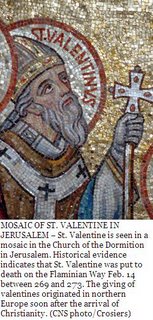 LONDON – The man behind Feb. 14, when lovers around the world exchange cards and gifts, has been largely forgotten on his own feast day. Such little significance is attached to the memory of St. Valentine that even in the Spanish capital of Madrid in 2005 only a handful of people visited the Church of St. Anton, where what is believed to be his skeleton is kept on a side altar in a glass-fronted baroque case.
LONDON – The man behind Feb. 14, when lovers around the world exchange cards and gifts, has been largely forgotten on his own feast day. Such little significance is attached to the memory of St. Valentine that even in the Spanish capital of Madrid in 2005 only a handful of people visited the Church of St. Anton, where what is believed to be his skeleton is kept on a side altar in a glass-fronted baroque case.The giving of valentines originated in northern Europe soon after the arrival of Christianity. In England, St. Valentine's Day customs were mentioned by St. Bede, a Benedictine monk, as early as the eighth century. References later appear in the works of Geoffrey Chaucer and William Shakespeare.
In medieval France, the feast day was marked by jousting tournaments punctuated by recitals of amorous poetry. In European countries, as in North America, St. Valentine is very much the "patron saint of lovers."
Historians have speculated that St. Valentine came to be given this title because his feast day fell around the time of Lupercalia, a pagan Roman festival of carnal love that later took on a more Christian character as well as the saint's name. For this to happen – if it is true – St. Valentine must have been highly regarded by the early Roman Christians.
At least one St. Valentine existed, as evident from third-century Roman cults. The "Roman Martyrology" mentions two St. Valentines, one a priest and one a bishop. Both were put to death on the Flaminian Way on a Feb. 14 between 269 and 273, although some scholars have argued that the cults point to the saints being the same person.
The relics in Madrid are said to be those of the bishop of Terni, Italy, who was just 20 years old when he was consecrated by St. Felician of Foligno, Italy, in 197 on the orders of Pope Victor I. For 73 years, this St. Valentine built up his diocese in the face of persecution: preaching, tending to the sick and visiting Christians jailed for refusing to renounce their faith.
In 270, under Emperor Claudius II or Claudius the Goth, St. Valentine was incarcerated. While in prison, he was said to have healed the daughter of a prison official, resulting in the conversion of the official and his family. St. Valentine was beaten and finally beheaded, at the age of 93, on the orders of Furius Placidus, prefect of Rome.
The saint is described as a brave, righteous and wise man and a kind and conscientious friend to those in need.
According to tradition, St. Valentine also cared deeply for the young: He taught lovers to read and write letters to one another, presented flowers to newlyweds and helped married couples in difficulties.
How much of this is truth or legend, or a mixture of both, is impossible to say. A popular story of St. Valentine, for instance, tells of how he celebrated the wedding of Serapia, a Christian, to Sabino, her pagan lover. Serapia died and her grieving husband, who had become a Christian, asked God to let him join her in the grave, a wish generously granted through the intercession of the saint.
What is known to be true is that shortly after St. Valentine's death, Pope Julius I ordered a church built in his honor on the site of his execution; the church was enlarged to a basilica with three naves and a crypt, where the saint's body was kept. The basilica was destroyed in the Dark Ages, but by then the relics had been transferred to the safety of the catacombs of St. Valentine, north of Rome. There they stayed until the 18th century, when they were discovered along with the remains of hundreds of other Roman saints and martyrs.
The findings presented the Vatican with the problem of what to do with the relics because there was not enough room in the Roman churches to venerate all of them. Vatican officials decided that some would be sent as gifts to the Catholic monarchs of Europe. St. Valentine and St. Pantaleon went to Spain.
The bones of St. Valentine, along with a papal certificate of authenticity, were placed in the care of the Royal College of San Anton and kept in the sacristy of the adjacent church. In 1936, they were hidden away once again, this time from communists. They were rediscovered half a century later and in 1986 were put on public display.
Today, they are there for all to see – the remains of a man whose name is synonymous with romance but who died consumed by a fiery love of a different kind.
- Copyright (c) 2006 Catholic News Service/U.S. Conference of Catholic Bishops
This Post's Link

No comments:
Post a Comment